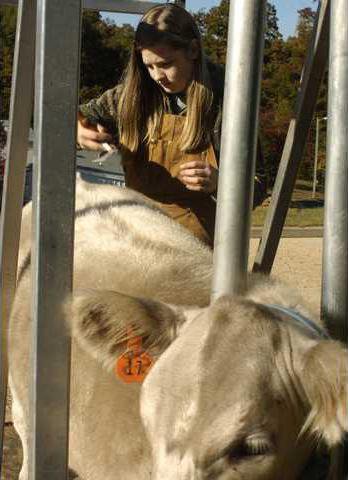Cow lingo
- Bull: An uncastrated male bovine, used to father cattle in a herd
- Calf: Baby cow
- Cow: A female bovine, also a generic term used to refer to cattle
- Heifer: Young female cow, raised to replace the older cows in a herd or for meat
- Steer: Castrated male bovine, raised and fed well to provide meat
Source: Cowboy Showcase Web site
Casie Conner has become a rarity in Hall County — a teenager who shows cattle.
While 52 young men and women participated in the Hall County Cattlemen’s Association’s 18th Annual Steer and Heifer Show on Saturday at the Chicopee Woods Agricultural Center, only one entry, Conner’s 6-month old Charolais-Angus mix "Oakie," came from Hall.
It’s a sign of the times for Hall County, an area that grew from agricultural roots but whose cattle farms have given way to development. "We lost three farms in the last five years to subdivisions," said Cattlemen’s Association President Ronnie Green. "You can’t raise cows on $25,000-per-acre land."
Conner’s father, Ricky, has one of the few remaining cattle farms in Hall County. Her cousin, Alicia, was the first Hall County resident to show cattle in five years when she began entering the competitions six years ago.
Meanwhile, Jackson, Habersham, Lumpkin and Dawson counties continue to be well-represented in the shows, where heifers, steers and their handlers are judged on everything from appearance to attitude.
Showing cattle can be a time-consuming and costly hobby. While Conner’s Oakie was raised on her farm, some competitors spend anywhere from $1,500 to $5,000 to purchase heifers and steers for show.
Right from birth, they get special treatment, from their regular feedings and brushings to the daily, milelong walks and weekly baths.
"There’s a tremendous amount of time and effort put into it," Green said.
Casie Conner, 16, has entered shows for the past four years. On Saturday, Oakie’s smoke-colored coat got pampered with electric clippers, mousse, hairspray and an aerosol spray called "Pink Oil" that brought out the sheen in her fur.
Conner doesn’t mind all the work that goes into showing cattle.
"I like the responsibility, and the relationships you make with other people at the shows," she said.
And Oakie, who will grow up to be a brood or "momma cow," takes to her handler the more time they spend together.
"It’s like having a dog," Conner said. "They follow you everywhere."
Despite the dearth of Hall County entries, the cattle industry is thriving in North Georgia, said Saturday’s judge, Nicholas Moody, a young farmer adviser from Stephens County who judges about a dozen times a year.
But today’s 4-H and Future Farmers of America students are often "nontraditional," using specially built facilities, and not the family farm, for their projects, Moody said.
Alicia Conner, now a 19-year-old sophomore at Abraham Baldwin Agricultural College, hopes to one day sell show calves at her own farm. She believes more people should come out to admire these bovine beauties.
"Every kid should come to at least one cow show in their life," she said.

